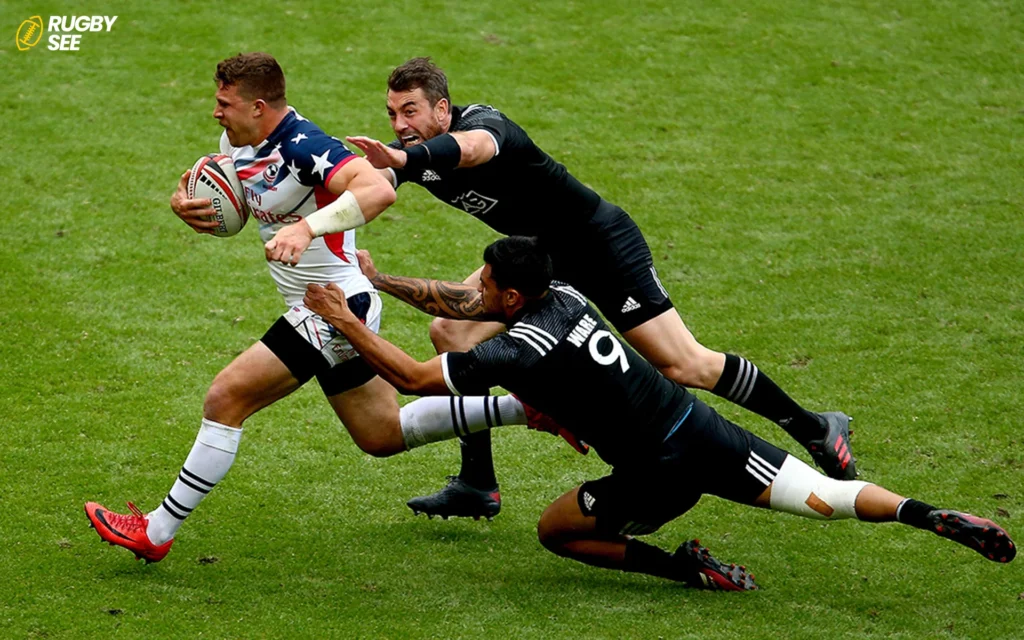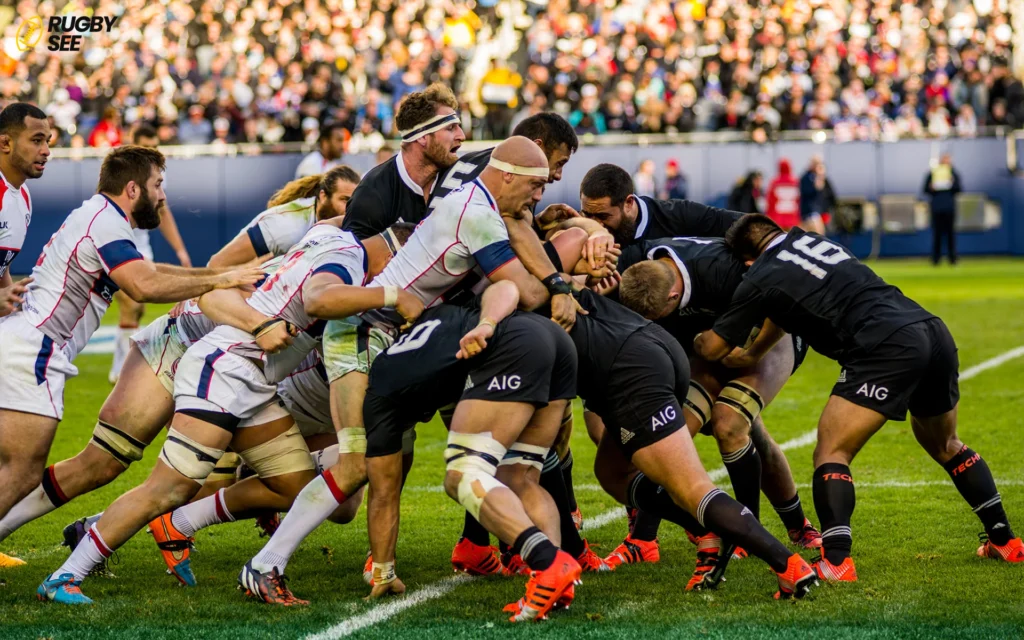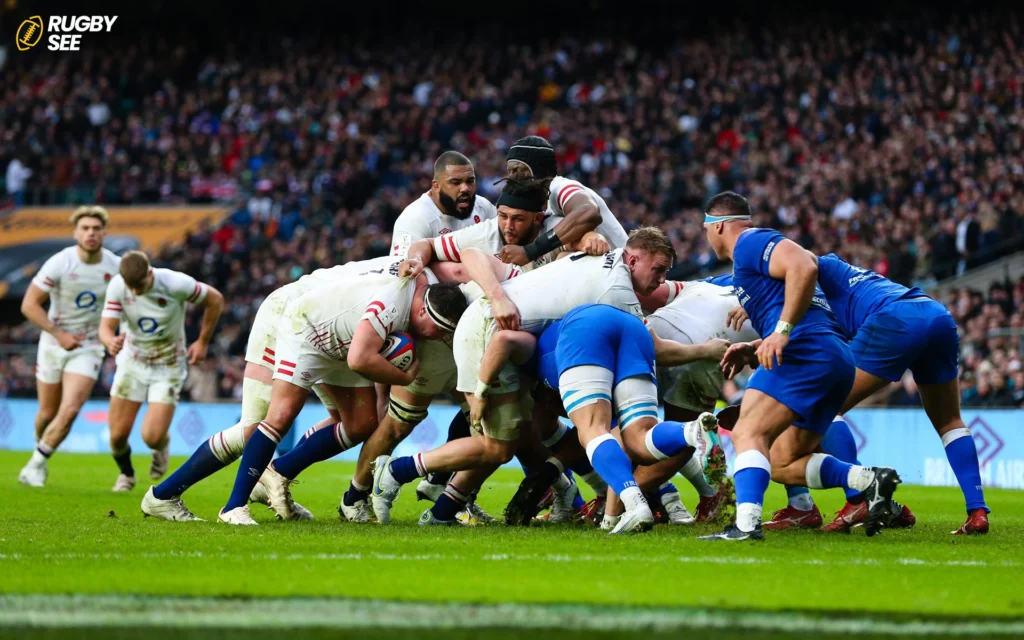When comparing the sizes of sports fields, one of the most common questions asked is whether a rugby field is bigger than a football field. This question arises due to the visual similarities between the two, but despite these similarities, there are distinct differences in the dimensions and layouts of each field, which reflect the unique needs and rules of each sport.
Understanding Field Dimensions
Rugby Field Dimensions
A standard rugby field is as per the World Rugby’s regulations, typically about 100 meters (109.36 yards) long and 70 meters (76.55 yards) wide. These measurements do not include the goal or “in-goal” areas – the zones behind the goalposts where tries are scored. Including these areas, the total length of a rugby field can reach up to 144 meters (157.48 yards). The in-goal area must be at least 10 meters (about 11 yards) and no more than 22 meters (24 yards) deep.
Football Field Dimensions
An American football field, on the other hand, measures 120 yards (109.73 meters) long, which includes two 10-yard (9.14 meters) end zones, and 53.33 yards (48.76 meters) wide. The total play area of a football field is thus 360 feet (120 yards) by 160 feet (53.33 yards).
Comparison of Field Sizes
When looking at the numbers, a rugby field can be longer than a football field if one includes the in-goal areas at their maximum size. However, a rugby field is typically narrower than a football field. In terms of overall square footage, a maximum-size rugby field (including its largest legal in-goal area) covers approximately 10,440 square meters (112,392 square feet). In contrast, a football field covers about 5,351 square meters (57,600 square feet).

Therefore, if we consider the potential maximum length, a rugby field can be considerably longer than a football field, but it’s important to note that this length rarely comes into play during the game, as much of the action occurs within the main play area, excluding the in-goal areas.
How Field Size Impacts Game Play
The differences in field size between rugby and football fields are not just incidental; they significantly affect how each game is played. In rugby, the wider field allows for more lateral movement, which is crucial given the continuous nature of the sport. Rugby players use the entire width of the field to execute complex plays and to outmaneuver their opponents.
Football requires less lateral space but more end-to-end space. The narrower but longer field setup, including end zones, suits the play style of American football, which involves forward passing and strategic positioning to reach the end zones. The design of the football field accommodates the stop-start nature of the game, where plays are executed in short bursts of intense activity and if you want to know about Rugby players Big Arms read How do rugby players get big arms?
Rules Influencing Field Usage
Each sport not only has specific field sizes but also distinct rules that influence how the field is used. For instance, rugby’s rules about passing (the ball cannot be passed forward) mean that players must be more strategic about lateral and backward passes across the wider field. Meanwhile, American football’s forward pass plays a crucial role in crossing the field longitudinally, necessitating a longer field.
While a rugby field can be longer and has a larger total area than a football field, the functional playing area of a football field is designed to support the unique requirements of the sport, emphasizing length including end zones important for scoring. Both fields serve their respective sports’ needs, providing the necessary space for the physical and strategic elements of play to unfold effectively.

Understanding these differences highlights the adaptations and considerations each sport makes to provide the most engaging and competitive environment for players and fans alike. This comparison not only answers the question of size but also reflects deeper elements of strategy and design inherent in the world of sports.
Field Markings and Their Functional Significance
Rugby Field Markings
Rugby fields are not only larger in terms of area but also feature more complex markings than football fields. These include the halfway line, the 22-meter lines, and the 10-meter lines from the halfway line. Each of these markings plays a critical role in the regulation of play. For instance, the 22-meter line is crucial for determining where kicks can be made and how players can re-enter the play. These markings enhance the strategic depth of rugby, as positioning within these lines can significantly affect the flow of the game and team tactics.
Football Field Markings
In contrast, a football field features yard lines marked every 5 yards and numbered every 10 yards, extending from each end zone to the center of the field. These markings are critical for determining progress toward scoring and are integral to the game’s structure, reflecting its play-by-play tactical evolution. The end zones are clearly marked as the scoring areas, which are pivotal in the game’s objective of crossing into these zones to score touchdowns.
Player Interaction with the Field
Impact of Rugby’s Field Size on Players
The larger playing surface in rugby not only affects game strategies but also influences the physical demands placed on players. Rugby players must have high endurance and speed to navigate the larger field, often leading to more dynamic and physically demanding gameplay. The field’s size allows for a more spread-out game, reducing congestion and collisions but increasing the importance of stamina and tactical spacing.

Impact of Football’s Field Dimensions on Players
Football players, while also benefiting from speed and physical strength, operate in a more structured and segmented field space. The narrower width of the field concentrates action and impacts, making physical strength and strategic positioning even more crucial. The emphasis on vertical movement down the field aligns with the sport’s structured set of downs and the need to advance the ball in stages toward the opponent’s end zone.
Cultural and Spectator Experience
Viewing Experience in Rugby
The wide rugby field provides a panoramic viewing experience for spectators, whether in the stands or watching on television. The broad view allows fans to appreciate the complex formations and strategies unfolding across the entire field. This setup demands a broader attention span and a deeper understanding of the game to appreciate the nuances of play spread over a larger area and if you want to know about Half Time in Rugby read does rugby have half time?
Viewing Experience in Football
Football’s narrower field provides a more focused viewing experience. Spectators can see plays develop in a more linear fashion, which aligns with the game’s forward progression and strategic execution. This focused perspective makes it easier for new fans to follow the action and understand the game’s objectives, contributing to its widespread popularity in regions like the United States.
Ultimately, the comparison between rugby and football fields illustrates how each sport’s field dimensions are tailored to its specific gameplay and strategic demands. Rugby fields accommodate a free-flowing, endurance-focused game that requires using a broad area for tactical maneuvers. In contrast, football fields complement a structured, strategic form of play that emphasizes territory gain in a more concentrated area. Both sports have evolved with field designs that enhance their distinctive styles, making each unique not just in how the game is played but in how it is experienced by players and fans alike.










